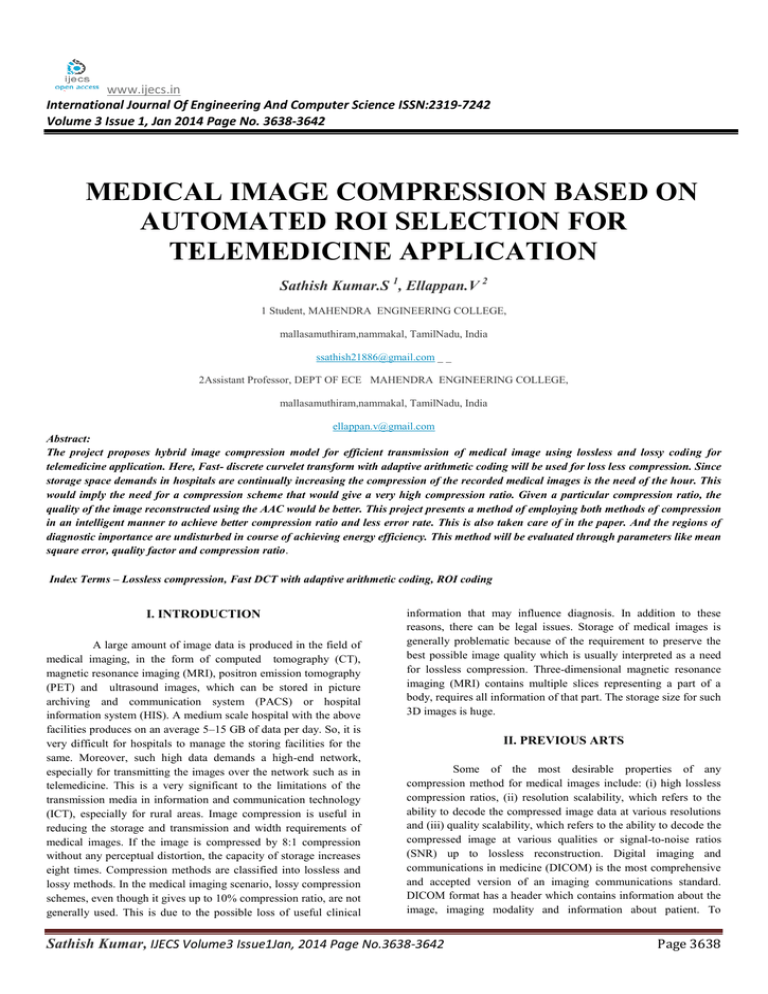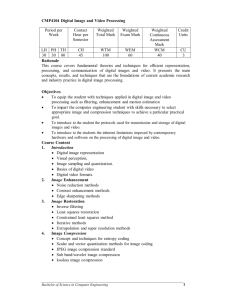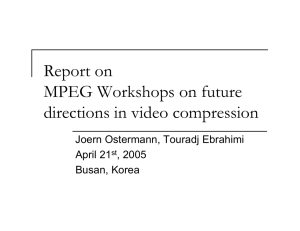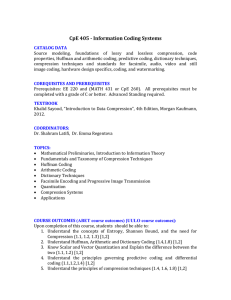www.ijecs.in International Journal Of Engineering And Computer Science ISSN:2319-7242
advertisement

www.ijecs.in International Journal Of Engineering And Computer Science ISSN:2319-7242 Volume 3 Issue 1, Jan 2014 Page No. 3638-3642 MEDICAL IMAGE COMPRESSION BASED ON AUTOMATED ROI SELECTION FOR TELEMEDICINE APPLICATION Sathish Kumar.S 1, Ellappan.V 2 1 Student, MAHENDRA ENGINEERING COLLEGE, mallasamuthiram,nammakal, TamilNadu, India ssathish21886@gmail.com _ _ 2Assistant Professor, DEPT OF ECE MAHENDRA ENGINEERING COLLEGE, mallasamuthiram,nammakal, TamilNadu, India ellappan.v@gmail.com Abstract: The project proposes hybrid image compression model for efficient transmission of medical image using lossless and lossy coding for telemedicine application. Here, Fast- discrete curvelet transform with adaptive arithmetic coding will be used for loss less compression. Since storage space demands in hospitals are continually increasing the compression of the recorded medical images is the need of the hour. This would imply the need for a compression scheme that would give a very high compression ratio. Given a particular compression ratio, the quality of the image reconstructed using the AAC would be better. This project presents a method of employing both methods of compression in an intelligent manner to achieve better compression ratio and less error rate. This is also taken care of in the paper. And the regions of diagnostic importance are undisturbed in course of achieving energy efficiency. This method will be evaluated through parameters like mean square error, quality factor and compression ratio. Index Terms – Lossless compression, Fast DCT with adaptive arithmetic coding, ROI coding I. INTRODUCTION A large amount of image data is produced in the field of medical imaging, in the form of computed tomography (CT), magnetic resonance imaging (MRI), positron emission tomography (PET) and ultrasound images, which can be stored in picture archiving and communication system (PACS) or hospital information system (HIS). A medium scale hospital with the above facilities produces on an average 5–15 GB of data per day. So, it is very difficult for hospitals to manage the storing facilities for the same. Moreover, such high data demands a high-end network, especially for transmitting the images over the network such as in telemedicine. This is a very significant to the limitations of the transmission media in information and communication technology (ICT), especially for rural areas. Image compression is useful in reducing the storage and transmission and width requirements of medical images. If the image is compressed by 8:1 compression without any perceptual distortion, the capacity of storage increases eight times. Compression methods are classified into lossless and lossy methods. In the medical imaging scenario, lossy compression schemes, even though it gives up to 10% compression ratio, are not generally used. This is due to the possible loss of useful clinical information that may influence diagnosis. In addition to these reasons, there can be legal issues. Storage of medical images is generally problematic because of the requirement to preserve the best possible image quality which is usually interpreted as a need for lossless compression. Three-dimensional magnetic resonance imaging (MRI) contains multiple slices representing a part of a body, requires all information of that part. The storage size for such 3D images is huge. II. PREVIOUS ARTS Some of the most desirable properties of any compression method for medical images include: (i) high lossless compression ratios, (ii) resolution scalability, which refers to the ability to decode the compressed image data at various resolutions and (iii) quality scalability, which refers to the ability to decode the compressed image at various qualities or signal-to-noise ratios (SNR) up to lossless reconstruction. Digital imaging and communications in medicine (DICOM) is the most comprehensive and accepted version of an imaging communications standard. DICOM format has a header which contains information about the image, imaging modality and information about patient. To Sathish Kumar, IJECS Volume3 Issue1Jan, 2014 Page No.3638-3642 Page 3638 compress such a DICOM file, special attention should be given to header information. Distortion-limited wavelet image codec performs better in Case of medical images of large sizes, lossy compression is implemented by multiplexing a small number of wavelet coefficients, resulting in statistically higher compression results concerning the file size. However, lossy medical image compression is considered to be unacceptable for performing diagnosis in most of the medical imaging applications, owing to quality degradation. Over the past several years, the wavelet transform has gained widespread acceptance in signal processing in general and in image compression research in particular. In applications such as still image compression, discrete wavelets transform (DWT) based schemes have outperformed other coding schemes like the ones based on DCT. Since there is no need to divide the input image into non-overlapping 2-D blocks and its basis functions have variable length, wavelet-coding schemes at higher compression ratios avoid blocking artifacts. Because of their inherent multi -resolution nature, wavelet-coding schemes are especially suitable for applications where scalability and tolerable degradation are important. Recently the JPEG committee has released its new image coding standard, JPEG-2000, which has been based upon DWT. Basically we use Wavelet Transform (WT) to analyze non-stationary signals, i.e., signals whose frequency response varies in time, as Fourier Transform (FT) is not suitable for such signals. III. PROPOSED METHOD Input Image Clustering Model FDCT Region Selection AAC Bit Streams Performance Analysis Reconstructed Image The MRI brain tumour image is considered for this region based image compression. The primary tumour region is selected using clustering model to segment it. The image will be extracted through mapping the primary region on input image. Primary region will be compressed by using fast discrete curvelet transform and adaptive arithmetic coding. The image (secondary region) to be compressed is transformed into frequency domain using wavelet transform. In wavelet transform the images are divided into odd and even components and finally the image is divided into four levels of frequency components. Segmentation is the process of partitioning a digital image into multiple segments (sets of pixels, also known as super pixels). The goal of segmentation is to simplify and/or change the representation of an image into something that is more meaningful and easier to analyze. Image segmentation is typically used to locate objects and boundaries (lines, curves, etc.) in images. More precisely, image segmentation is the process of assigning a label to every pixel in an image such that pixels with the same label share certain visual characteristics. The result of image segmentation is a set of segments that collectively cover the entire image, or a set of contours extracted from the image (see edge detection). Each of the pixels in a region is similar with respect to some characteristic or computed property, such as colour, intensity, or texture. Adjacent regions are significantly different with respect to the same characteristic(s) when applied to a stack of images, typical in medical imaging, the resulting contours after image segmentation can be used to create 3D reconstructions with the help of interpolation algorithms like marching cubes. Inverse Transforms Decoding Clustering Model The K-means algorithm is an iterative technique that is used to partition an image into K clusters. The basic algorithm is: 1. Pick K cluster centers, either randomly or based on some heuristic 2. Assign each pixel in the image to the cluster that minimizes the distance between the pixel and the cluster center. 3. Re-compute the cluster centers by averaging all of the pixels in the cluster 4. Repeat steps 2 and 3 until convergence is attained (e.g. no pixels change clusters) In this case, distance is the squared or absolute difference between a pixel and a cluster centre. The difference is typically based on pixel colour, intensity, texture, and location, or a weighted combination of these factors. K can be selected manually, randomly, or by a heuristic. This algorithm is guaranteed to converge, but it may not return the optimal solution. The quality of the solution depends on the initial set of clusters and the value of K. In statistics and machine learning, the k-means algorithm is a clustering algorithm to partition n objects into k clusters, where k < n. It is similar to the expectation-maximization algorithm for mixtures of Gaussians in that they both attempt to find the centres of natural clusters in the data. The model requires that the object attributes correspond to elements of a vector space. The objective it tries to achieve is to minimize total intra-cluster variance, or, the squared error function. The k-means clustering was invented in 1956. The most common form of the algorithm uses an iterative refinement heuristic known as Lloyd's algorithm. Lloyd's algorithm Sathish Kumar, IJECS Volume3 Issue1Jan, 2014 Page No.3638-3642 Page 3639 starts by partitioning the input points into k initial sets, either at random or using some heuristic data. It then calculates the mean point, or centroid, of each set. It constructs a new partition by associating each point with the closest centroid. Then the centroids are recalculated for the new clusters, and algorithm repeated by alternate application of these two steps until convergence, which is obtained when the points no longer switch clusters (or alternatively centroids are no longer changed). Cluster analysis, an important technology in data mining, is an effective method of analyzing and discovering useful information from numerous data. Cluster algorithm groups the data into classes or clusters so that objects within a cluster have high similarity in comparison to one another, but are very dissimilar to objects in other clusters. Dissimilarities are assessed based on the attribute values describing the objects. Often, distance measures are used. As a branch of statistics and an example of unsupervised learning, clustering provides us an exact and subtle analysis tool from the mathematic view K-means algorithm belongs to a popular partition method in cluster analysis. The most widely used clustering error criterion is squared-error criterion, it can be defined as Where J, is the sum of square-error for all objects in the database, Fast Discrete Curvelet transformation simpler and totally transparent. What is interesting here is that the new mathematical architecture suggests innovative algorithmic strategies, and provides the opportunity to improve upon earlier implementations. The two new fast discrete curvelet transforms (FDCTs) which are simpler, faster, and less redundant than existing proposals: Curvelets implementations are based on the original construction which uses a pre-processing step involving a special partitioning of phase-space followed by the ridgelet transform which is applied to blocks of data that are well localized in space and frequency. is the point in space representing a given object, and is the mean of cluster . Adopting the squared-error criterion, Kmeans works well when the clusters are compact clouds that are rather well separated from one another and are not suitable for discovering clusters with non convex shapes or clusters of very different size. For attempting to minimize the square-error criterion, it will divide the objects in one cluster into two or more clusters. In addition to that, when applying this square-error criterion to evaluate the clustering results, the optimal cluster corresponds to the extreme. Since the objective function has many local minimal values, if the result of initialization is exactly near the local minimal point, the algorithm will terminate at a local optimum. So, random selecting initial cluster center is easy to get in the local optimum not the entire optimal. For overcoming that square-error criterion is hard to distinguish the big difference among the clusters, one technique has been developed which is based on representative point-based technique. Besides, there are various approaches to solving the problem that the performance of algorithm heavily depends on the initial starting conditions: the simplest one is repetition with different random selections. • Curvelets via USFFT, and In the last two or three years, however, curvelets have actually been redesigned in an effort to make them easier to use and understand. As a result, the new construction is considerably • Curvelets via Wrapping Sathish Kumar, IJECS Volume3 Issue1Jan, 2014 Page No.3638-3642 Page 3640 The block size can be changed at each scale level. The wrapping construction is shown is taken to be a Cartesian array and ˆ f[n1, n2 ] denotes its 2-D discrete Fourier transform, then the architecture of the FDCT via wrapping is as follows. 1) Apply the 2-D FFT and obtain Fourier samples, 2) For each scale j and angle l, form the product Where Uj,l [n1, n2 ] is the discrete localizing window 3) Wrap this product around the origin and obtain where D is the number of symbols in the coded sequence alphabet. For example, if a coding method generates the sequence of bits 0011000101100, then we have Code sequence d = [0011000101100] Code value v = 0.0011000101100 2 = 0.19287109375 Where the ‘2’ subscript denotes base-2 notation. As usual, we omit the subscript for decimal notation. This construction creates a convenient mapping between infinite sequences of symbols from a D-symbol alphabet and real numbers in the interval [0, 1), where any data sequence can be represented by a real number, and viceversa. The code value representation can be used for any coding system and it provides a universal way to represent large amounts of information independently of the set of symbols used for coding (binary, ternary, decimal, etc.). For instance, in (1.5) we see the same code with base-2 and base-10 representations. We can evaluate the of any compression method by analyzing the distribution of the code values it produces. From Shannon's information theory ,we know that, if a coding method is optimal, then the cumulative distribution of its code values has to be a straight line from point (0, 0) to point (1, 1). It introduces the notation and equations that describe arithmetic encoding, followed by a detailed example. Fundamentally, the arithmetic encoding process consists of creating a sequence of nested intervals. 4) Apply the inverse 2-D FFT to each ˜ fj,l , hence collecting the discrete coefficients CD (j, l, k). Experimental Results Adaptive Arithmetic entropy Coding The performance of lossless coding was evaluated with MRI brain tumor image samples. Here taken samples and simulated primary region was represented with compression parameters. Arithmetic coding is different from other coding methods for which we know the exact relationship between the coded symbols and the actual bits that are written to a ¯le. It codes one data symbol at a time, and assigns to each symbol a real-valued number of bits To figure out how this is possible, we have to understand the code value representation: coded messages mapped to real numbers in the interval [0, 1). The code value v of a compressed data sequence is the real number with fractional digits equal to the sequence's symbols. We can convert sequences to code values by simply adding \0." to the beginning of a coded sequence, and then interpreting the result as a number in base-D notation, Fig: a) input b) primary region c) decoded image The following chart shows performance metrics of coding technique. Sathish Kumar, IJECS Volume3 Issue1Jan, 2014 Page No.3638-3642 Page 3641 heterogeneous radio networks’, Trans. Inf. Technol. Biomed., 2009,13, (4), pp. 458–466 120 100 80 60 40 20 0 [8] Doukas, C., Maglogiannis, I.: ‘Region of interest coding techniques for Medical image compression’, IEEE Eng. Med. Biol. Mag., 2007, 26, (5), pp. 29–35 [9] Zhang, Q., Xiaio, X.: ‘Extracting regions of interest in biomedical Images’. Int. Seminar on Future BioMedical Information Engineering, 2008, pp. 3–6 [10] Yu, Y., Wang, B.: ‘Saliency based compressive sampling for image signals’, IEEE Signal Process. Lett., 2010, 17, (11), pp. 973–976 Fig.2: values of parameters CONCLUSION This project presented to provide solutions for efficient region based image compression for increasing the compression ratio with less mean square error at minimum processing time based on Fast discrete curvelet transform with adaptive arithmetic coding, Lifting wavelet transform with set partitioning Embedded block coding. This project heavily utilized for compressing medical images to transmit for telemedicine application. To minimize the information loss, arithmetic entropy coding was used effectively. It will be enhanced by combining speck coding for compressing the secondary region and this hybrid approach was increased the CR and reduce the information loss. Here performance will be analyzed through determining the image quality after decompression, compression ratio, correlation and execution time. REFERENCES [1] Maglogiannis, I., Kormentzas, G.: ‘Wavelet-based compression with ROI coding support for mobile access to DICOM images over heterogeneous radio networks’, Trans. Inf. Technol. Biomed., 2009, 13, (4), pp. 458–466 [2] Doukas, C., Maglogiannis, I.: ‘Region of interest coding techniques for medical image compression’, IEEE Eng. Med. Biol. Mag., 2007, 26, (5), pp. 29–35 [3] Zhang, Q., Xiaio, X.: ‘Extracting regions of interest in biomedical images’. Int. Seminar on Future BioMedical Information Engineering, 2008, pp. 3–6 [4] Yu, Y., Wang, B.: ‘Saliency based compressive sampling for image signals’, IEEE Signal Process. Lett., 2010, 17, (11), pp. 973–976 [5] Calderbank, A.R., Daubechies, I., Sweldens, W., Yeo, B.L.: ‘Wavelet transforms that map integers to integers’, Appl. Comput. Harmon. Anal., 1998, 5, pp. 332–369 [6]Sanchez, V., Abugharbieh, R., Nasiopoulos, P.: ‘Symmetrybased scalable lossless compression of 3D medical image data’, IEEE Trans. Med. Imaging, 2009, 28, (7), pp. 1062–1071 [7] Maglogiannis, I., Kormentzas, G.: ‘Wavelet-based compression with ROI coding support for mobile access to DICOM images over Sathish Kumar, IJECS Volume3 Issue1Jan, 2014 Page No.3638-3642 Page 3642





